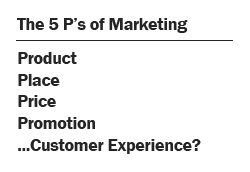The majority of us (I hope) understand the importance of improving customer experience. Without our customers, we couldn’t even be in business. They’re central to everything we do—and we need to treat them that way. But too few companies are making customer experience a key factor in planning their marketing campaigns.
 The traditional marketing mix consists of the product (or service), place, price and promotion—i.e., the “4 Ps” of marketing. Now, customer experience may not start with a “P” like the others, but thinking about how customers touch your brand is crucial to how they perceive and interact with it. In fact, building customer loyalty begins at the first touchpoints many prospective customers encounter—your marketing.
The traditional marketing mix consists of the product (or service), place, price and promotion—i.e., the “4 Ps” of marketing. Now, customer experience may not start with a “P” like the others, but thinking about how customers touch your brand is crucial to how they perceive and interact with it. In fact, building customer loyalty begins at the first touchpoints many prospective customers encounter—your marketing.
In June, Robert Reiss, host of The CEO TV Show, moderated a panel of executives from three major companies. What he gathered was vital insight into how and why their companies are so focused on making customer experience their 5th marketing “P.” These executives have learned a lot in the process—and I’ll bet there’s something of interest to your company, too.
Completely Integrating the Customer Experience into Marketing
Though this is changing quickly, marketing is still more art than science. You need to see where your market and customers are headed before they even arrive there. It’s tricky, but for those executives who truly understand who their customer is, it can be a well-oiled machine.
For executives at Hallmark, UPS and Verizon Wireless, integrating CX-related data into campaign planning has become essential to their businesses' success in building customer loyalty.
How Hallmark, UPS, and Verizon Use Data in Their Marketing Strategies
Lisa Macpherson, SVP of Marketing at Hallmark, said their customers want transparency and authentic interactions. And that insight has led the company away from strictly calendar-based, seasonal marketing campaigns.
Instead, they’re leaning more on behavioral and transactional data to connect with customers better. It’s no longer about a generic Valentine’s Day advertisement, but messaging target to what a customer has purchased in the past. They even go so far as to mirror the tone and style of past purchases in their communications (e.g., intimate, heart-felt marketing messages reflective of customers’ cards.)
Alan Gershenhorn, Chief Sales, Marketing, and Strategy Officer for UPS, talked about how they leverage the company’s unrivaled knowledge of supply chain and logistics to make personalized strategy recommendations to business customers. UPS claims to be in the business of “helping [their] customers become more successful.” But there’s actual substance behind that statement. By building the marketing relationship on specific new revenue and cost saving opportunities mined from the customer’s history, UPS is truly making customer experience the “5th P.”
At Verizon, they’re unlocking the power of customer experience in lifecycle marketing. Ken Dixon, VP and CMO, said Verizon uses a customer’s purchasing history to create specific product recommendations or advise a customer that it might be time to upgrade his or her software to receive all the latest and greatest benefits. But they take it one step further. Verizon is also looking at the purchases of people who recently upgraded from your phone model—using the preferences and experience of similar customers to improve the quality of their recommendations (check out this Wikipedia entry on Collaborative Filtering if you want to know more).
How YOUR Company Can Incorporate Customer Experience into Marketing
So, all of this is well and good, but what can your business do right now to start bringing the customer experience into your marketing? The one common thread throughout Macpherson, Gershenhorn and Dixon’s answers was this: use what you already know about your customer, and simply start using it better.
Most likely, you already have your customers’ purchasing histories. Take a page from Hallmark, UPS, and Verizon and delve right into what your target market buys from you, as well as things like when, where and how they do. Understanding your customers’ past behaviors helps you to anticipate how they want to interact with the company. Do they prefer for you to make product suggestions? Would they rather you speak to them based on their needs that season? By thinking about what you already know about the customer and their experience preferences, you’re able to focus all of your marketing efforts around them and show your company is authentically interested in providing the best experience you can.
So, maybe customer experience doesn’t start with a P. But understanding your customers’ preferences does. And if you can understand and deliver on those, you’re on your way.
This blog originally ran on CMO.com, where Michael Hinshaw writes the weekly “Get Customer-Centric” blog.

